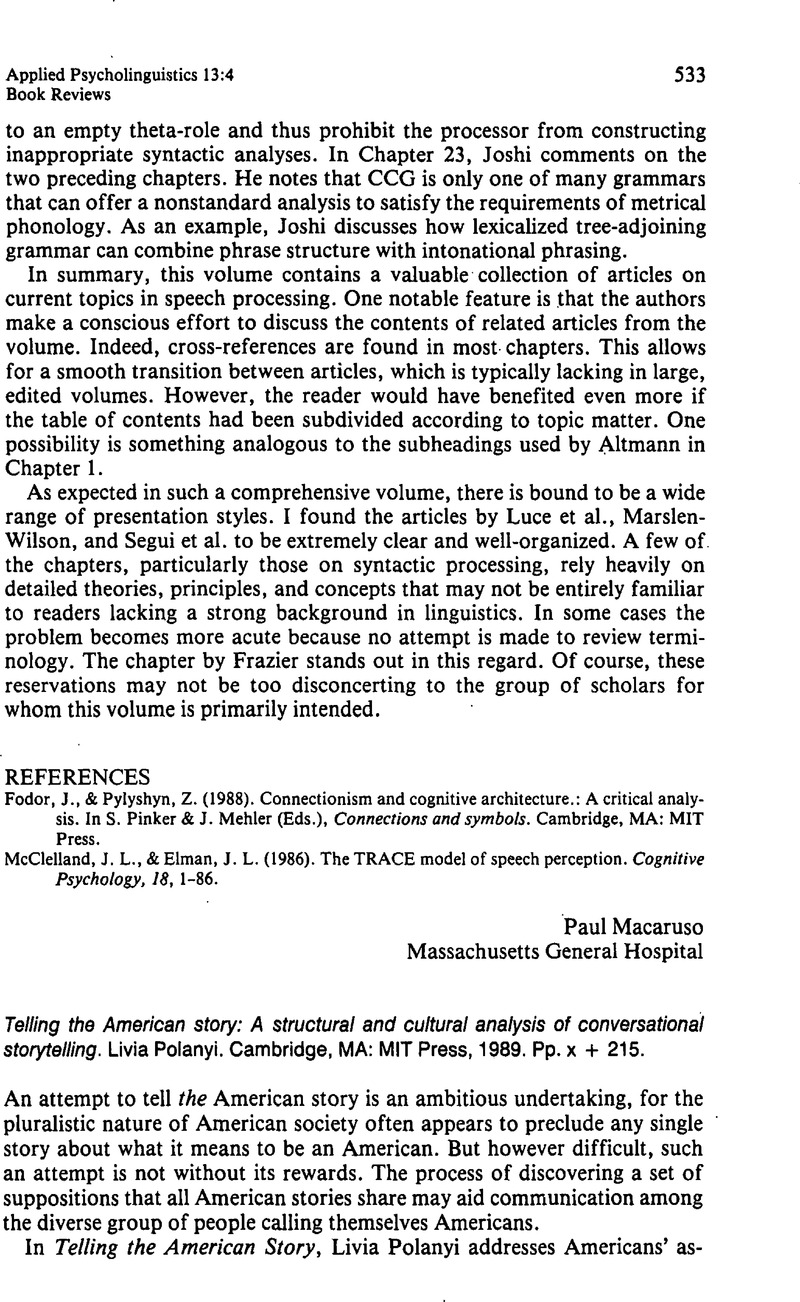No CrossRef data available.
Article contents
Telling the American story: A structural and cultural analysis of conversational storytelling. Polanyi Livia. Cambridge, MA: MIT Press, 1989. Pp. x + 215.
Published online by Cambridge University Press: 28 November 2008
Abstract
An abstract is not available for this content so a preview has been provided. Please use the Get access link above for information on how to access this content.

- Type
- Book Reviews
- Information
- Copyright
- Copyright © Cambridge University Press 1992
References
REFERENCES
Gregory, L., & Tabors, P. (1991, 10). We was singing and we was dancing: A cross-cultural analysis of black and white preschool children's personal accounts. Paper presented at the Boston University Conference on Language Development.Google Scholar
Jefferson, G. (1979). Sequential aspects of storytelling in conversation. In Schenkein, J. (Ed.), Studies in the organization of conversational interaction (pp. 219–248). New York: Academic.Google Scholar
Labov, W. (1972). Language in the inner city. Philadelphia: University of Pennsylvania Press.Google Scholar
Labov, W., & Waletzky, J. (1967). Narrative analysis: Oral versions of personal experience. In Helm, J. (Ed.), Essays on the verbal and visual arts (pp. 12–44). Seattle: University of Washington Press.Google Scholar
Lakoff, G., & Johnson, M. (1980). Metaphors we live by. Chicago: University of Chicago Press.Google Scholar
Mandler, J. M., & Johnson, N. S. (1977). Remembrance of things parsed: Story structure and recall. Cognitive Psychology, 9, 111–151.CrossRefGoogle Scholar
Markus, H. R., & Kitayama, S. (1991). Culture and the self: Implications for cognition, emotion, and motivation. Psychological Review, 98, 224–253.CrossRefGoogle Scholar
Miller, P. J., & Sperry, L. (1988). Early talk about the past: The origins of conversational stories of personal experience. Journal of Child Language, 15, 293–315.CrossRefGoogle ScholarPubMed
Rodino, A. M., Gimbert, C., Perez, C., Craddock, Willis K., & McCabe, A. (1991, 10). Getting your point across: Contrastive sequencing in low-income American and Latino children's personal narratives. Paper presented at the Boston University Conference on Language Development.Google Scholar
Rumelhart, D. (1975). Notes on a schema for stories. In Bobrow, D. & Collins, A. (Eds.), Representation and understanding (pp. 237–272). New York: Academic.Google Scholar
Sacks, H. (1972). On the analyzability of stories by children. In Gumperz, J. J. & Hymes, D. (Eds.), Directions in sociolinguislics: The ethnography of communication (pp. 325–345). New York: Holt, Rinehart & Winston.Google Scholar
Shweder, R., & Bourne, E. J. (1984). Does the concept of the person vary cross-culturally? In Shweder, R. & LeVine, R. A. (Eds.), Culture theory: Essays on mind, self and emotion (pp. 158–199). New York: Cambridge University Press.Google Scholar


